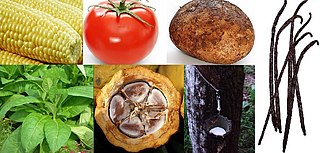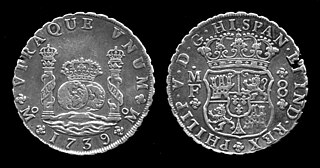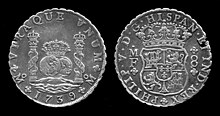The Price Revolution, sometimes known as the Spanish Price Revolution, was a series of economic events that occurred between the second half of the 15th century and the first half of the 17th century, and most specifically linked to the high rate of inflation that occurred during this period across Western Europe. Prices rose on average roughly sixfold over 150 years. This level of inflation amounts to 1.2% per year compounded, a relatively low inflation rate for modern-day standards, but rather high given the monetary policy in place in the 16th century.
The Haijin (海禁) or sea ban was a series of related isolationist policies in China restricting private maritime trading and coastal settlement during most of the Ming dynasty and early Qing dynasty. The policy introduced by the Ming founder Zhu Yuanzhang significantly hampered the growth of China's domestic trade, although the Ming was not able to enforce the policy in full despite official proclamations, and trade continued in forms like smuggling until the late Ming government opened the port of Yuegang for trade. Later, the early Qing dynasty's anti-insurgent "Great Clearance" (1661-1683) also caused considerable devastating effects on communities along the coast, until the Qing seized control of Taiwan and opened coastal ports to foreign trade.

A reserve currency is a foreign currency that is held in significant quantities by central banks or other monetary authorities as part of their foreign exchange reserves. The reserve currency can be used in international transactions, international investments and all aspects of the global economy. It is often considered a hard currency or safe-haven currency.

The Spanish dollar, also known as the piece of eight, is a silver coin of approximately 38 mm (1.5 in) diameter worth eight Spanish reales. It was minted in the Spanish Empire following a monetary reform in 1497 with content 25.563 g (0.8219 ozt) fine silver. It was widely used as the first international currency because of its uniformity in standard and milling characteristics. Some countries countermarked the Spanish dollar so it could be used as their local currency.
The Manila galleon, originally known as La Nao de China, and Galeón de Acapulco, refers to the Spanish trading ships that linked the Spanish Crown's Viceroyalty of New Spain, based in Mexico City, with its Asian territories, collectively known as the Spanish East Indies, across the Pacific Ocean. The ships made one or two round-trip voyages per year between the ports of Acapulco and Manila from the late 16th to early 19th century. The name of the galleon changed to reflect from which city the ship sailed, setting sail from Cavite, in Manila Bay, at the end of June or first week of July, starting the return journey (tornaviaje) from Acapulco in March–April of the next calendar year, and returning to Manila in June–July.

The Columbian exchange, also known as the Columbian interchange, was the widespread transfer of plants, animals, precious metals, commodities, culture, human populations, technology, diseases, and ideas between the New World in the Western Hemisphere, and the Old World (Afro-Eurasia) in the Eastern Hemisphere, in the late 15th and following centuries. It is named after the Italian explorer Christopher Columbus and is related to the European colonization and global trade following his 1492 voyage. Some of the exchanges were purposeful; some were accidental or unintended. Communicable diseases of Old World origin resulted in an 80 to 95 percent reduction in the number of Indigenous peoples of the Americas from the 15th century onwards, most severely in the Caribbean. The cultures of both hemispheres were significantly impacted by the migration of people from the Old World to the New. European colonists and African slaves replaced Indigenous populations across the Americas, to varying degrees. The number of Africans taken to the New World was far greater than the number of Europeans moving to the New World in the first three centuries after Columbus.

Potosí, known as Villa Imperial de Potosí in the colonial period, is the capital city and a municipality of the Department of Potosí in Bolivia. It is one of the highest cities in the world at a nominal 4,090 m (13,420 ft). For centuries, it was the location of the Spanish colonial silver mint. A considerable amount of the city's colonial architecture has been preserved in the historic center of the city, which—along with the globally important Cerro Rico de Potosí—are part of a designated UNESCO World Heritage Site.
Trade dollars were silver coins minted as trade coins by various countries to facilitate trade with countries in East Asia, especially China and Japan. They all approximated in weight and fineness to the Spanish dollar, which had set the standard for a de facto common currency for trade in the Far East.

The patio process is a process for extracting silver from ore. Smelting, or refining, is most often necessary because silver is only infrequently found as a native element like some metals nobler than the redox couple 2 H+ + 2 e−⇌ H
2 (gold, mercury, ...). Instead, it is made up of a larger ore body. Thus, smelting, or refining, is necessary to reduce the compound containing the Ag+ cation into metallic Ag and to remove other byproducts to get at pure silver. The process, which uses mercury amalgamation to recover silver from ore, was first used at scale by Bartolomé de Medina in Pachuca, Mexico, in 1554. It replaced smelting as the primary method of extracting silver from ore at Spanish colonies in the Americas. Although some knowledge of amalgamation techniques were likely known since the classical era, it was in the New World that it was first used on a large industrial scale. Other amalgamation processes were later developed, importantly the pan amalgamation process, and its variant, the Washoe process. The silver separation process generally differed from gold parting and gold extraction, although amalgamation with mercury is also sometimes used to extract gold. While gold was often found in the Americas as a native metal or alloy, silver was often found as a compound such as silver chloride and silver sulfide, and therefore required mercury amalgamation for refinement.

The silver standard is a monetary system in which the standard economic unit of account is a fixed weight of silver. Silver was far more widespread than gold as the monetary standard worldwide, from the Sumerians c. 3000 BC until 1873. Following the discovery in the 16th century of large deposits of silver at the Cerro Rico in Potosí, Bolivia, an international silver standard came into existence in conjunction with the Spanish pieces of eight. These silver dollar coins played the role of an international trading currency for nearly four hundred years.

Silver mining is the extraction of silver from minerals, starting with mining. Because silver is often found in intimate combination with other metals, its extraction requires elaborate technologies. In 2008, ca. 25,900 metric tons were consumed worldwide, most of which came from mining.
Japanese currency has a history covering the period from the 8th century AD to the present. After the traditional usage of rice as a currency medium, Japan adopted currency systems and designs from China before developing a separate system of its own.

The Iwami Ginzan (石見銀山) was an underground silver mine in the city of Ōda, in Shimane Prefecture on the main island of Honshu, Japan. It was the largest silver mine in Japanese history. It was active for almost four hundred years, from its discovery in 1526 to its closing in 1923.

The economy of East Asia comprises 1.6 billion people living in six different countries and regions. The region includes several of the world's largest and most prosperous economies: Taiwan, Japan, South Korea, China, Hong Kong, and Macau. It is home to some of the most economically dynamic places in the world, being the site of some of the world's most extended modern economic booms, including the Taiwan miracle (1950–present) in Taiwan, Miracle on the Han River (1974–present) in South Korea, Japanese economic miracle (1950–1990) and the Chinese economic miracle (1983–2010) in China.

The economy of the Ming dynasty (1368–1644) of China was one of the largest in the world during that period. It is regarded as one of China's three major golden ages. The period was marked by the increasing political influence of the merchants, the gradual weakening of imperial rule, and technological advances.
The Single whip law or the "Single whip reform" was a fiscal law first instituted during the middle Ming dynasty, in the early 16th century, and then promulgated throughout the empire in 1580 by Zhang Juzheng.

Silver Dragon coins, also sometimes known as Dragon dollars, are silver coins issued by China, Japan and later Korea for general circulation in their own countries. Featuring a dragon on the obverse of Japanese and Korean issues and on the reverse of Chinese issues, all were inspired by the silver Spanish dollar which following its introduction into the region in the 16th Century had set the standard for a de facto common currency for trade in the Far East, this specification being a weight of 27.22 grams and a fineness of .900; the coin thus contained 24.5 g of silver.

The Great Bullion Famine was a shortage of precious metals that struck Europe in the 15th century, with the worst years of the famine lasting from 1457 to 1464. During the Middle Ages, gold and silver coins saw widespread use as currency in Europe, and facilitated trade with the Middle East and Asia; the shortage of these metals therefore became a problem for European economies. The main cause for the bullion famine was outflow of silver to the East unequaled by European mining output, although 15th century contemporaries believed the bullion famine to be caused by hoarding.

Qing dynasty coinage was based on a bimetallic standard of copper and silver coinage. The Manchu-led Qing dynasty was established in 1636 and ruled over China proper from 1644 until it was overthrown by the Xinhai Revolution in 1912. The Qing dynasty saw the transformation of a traditional cash coin based cast coinage monetary system into a modern currency system with machine-struck coins, while the old traditional silver ingots would slowly be replaced by silver coins based on those of the Mexican peso. After the Qing dynasty was abolished its currency was replaced by the Chinese yuan of the Republic of China.
The economy in the Indian Subcontinent during the Mughal Empire era performed just as it did in ancient times, though now it would face the stress of extensive regional tensions. It was described as large and prosperous. India producing about 28% of the world's industrial output up until the 18th century. While at the start of 17th century, the economic expansion within Mughal territories become the largest and surpassed Qing dynasty and Europe, where from Bengal Subah alone, the province statistically has contributed to 12% of Gross domestic product. by 1700s, Mughals had approximately 24 percent share of world's economy. They grew from 22.7% in 1600, which at the end of 16th century, has surpassed China to become the world's largest GDP.















